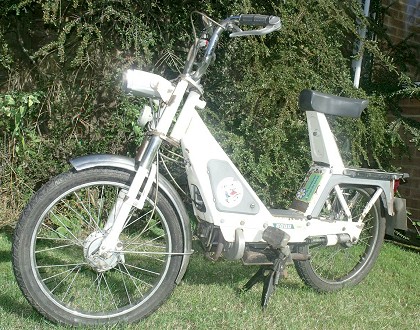Marcel Menneson and Maurice Goudard founded their original Solex Company at Paris in 1905, initially to manufacture vehicle radiators. Following the Great War, the Solex radiator business fell away, so the company bought the patent rights of Jouffrett and Renée to begin manufacture of carburettors instead. The business also diversified into making measuring equipment between the wars.
With France being overrun by the Axis powers in June 1940, it wasn’t long before fuel supplies started becoming restricted, so Solex set about the idea of trying to develop a simple and economical micro capacity engine to run on a bicycle. The first 38cc prototype motor with direct drive was completed in 1941 and mounted on a cycle frame for trial purposes, but for obvious reasons, the wartime period was not a particularly suitable time to develop the machine to production.
The way forward however was paved on 5 June 1943, when a French Vichy government decree re-defined the original Bicyclette à Moteur Auxilaire (BMA) specification into three newly qualified motor cycle categories as Motorcyclette over 125cc, Vélomoteur between 125cc and 50cc, and Bicyclette à moteur de secours (later called Cyclomoteur) under 50cc.
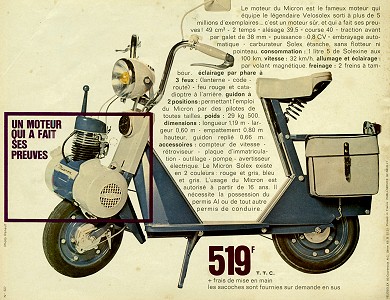
VéloSoleX Micron
With the stage now set for a new class of vehicles below 50cc, and a growing demand for low cost and reliable economy transport after WWII, a new company called SIFAC (Société Industrielle de Fabrication pour l’Automobile et le Cycle), was formed in May 1946 to manufacture the first production model Solex motorised cycle.
In 1965 the VéloSoleX manufacturing company modified its name to SINFAC (Société Industrielle Nouvelle de Fabrication pour l’Automobile et le Cycle); we have no idea why…
At the Milan Show at the end of 1967, SINFAC unveiled its new VéloSoleX Micron model, which was a sort of mini-scooter powered by an S3800 engine, but it didn’t have pedals. Without pedals, it became legally classified as a vélomoteur rather than a cyclomoteur.
Cyclomoteurs could be ridden from the age of 14, without a licence, and without having to be registered. A vélomoteur however, could only be ridden from the age of 16, and required both registration and a licence. Furthermore, the construction regulations required a vélomoteur to have three front lamps (main, dip, & side), a speedometer, and a rear view mirror.
So by the time the Micron had been adapted to meet the vélomoteur regulations, it cost 519F in 1968, compared to 393F for a conventional VéloSoleX S3800, so the Micron proved to be almost unsellable in France.
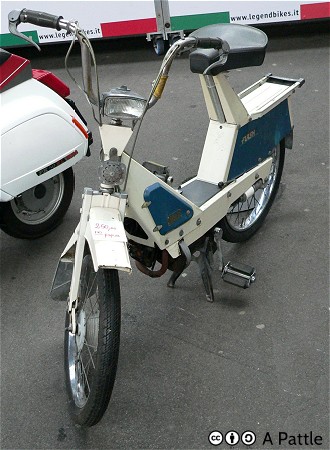
VéloSoleX Flash
Maybe the Micron’s only claim to company fame was that it became the first VéloSoleX to be finished in colours other than black.
At the Paris Salon in October 1968, SINFAC exhibited the first VéloSoleX Flash model, the frame construction of which was clearly a ‘grown-up’ version of the Micron, but with a completely new drive arrangement … and pedals.
Production models didn’t appear for sale until early 1969, and the price of the rigid version Flash in October 1969 was pitched to be the same as a Peugeot 102 at 559F, while a Flash with a leading-link fork and front drum brake was priced at 607F.
The Flash though, was beset by problems, particularly with its clutch and drive shaft, in sharp contrast to the utter reliability of its S3800 stable-mate.
In spring 1971, the Flash 71 was announced with ‘14 modifications’ to overcome the problems of the earlier models; however these modifications raised the prices to 640F for the basic rigid fork model, and 710F for the spring fork version.
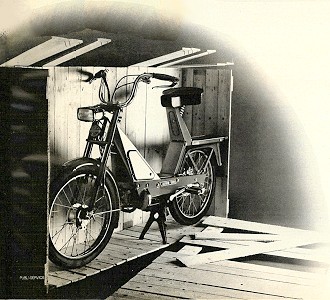
The new VéloSoleX 6000
Later in 1971 there were further modifications, and Flash became re-presented as the 6000 model, with a telescopic fork replacing the leading-link fork, a conventional front mudguard to replace the angular guard of the earlier Flash, and the side valances removed from the rear mudguard. The 6000 Standard with rigid fork & calliper brake was re-priced at 676F, while the telescopic fork version increased to 807F.
Our 1972 6000 is an odd looking machine … you could think that the original model for the frame might have been folded up from a sheet of paper by some Japanese Origami expert, then the production frame fabricated out of pressed-steel.
The bike appears a small and light machine, so we wheel it straight onto the scales, 2st 10lb front & 3st 1lb rear = just 5st 11lb total, or 37kg if you prefer.
With telescopic front forks and a small front drum brake of probably 70mm, we conclude our example must be a top-of-the-range ‘Télescopique’ model. At the top of the forks is a plastic Soubitez headlamp with just simple off–on switching, an electric horn on the bottom yoke, and a rear lamp by Transval TRG.
The wheels have 2.25×16 tyres on 1.2 Endrick pattern rims with 28 spokes and Atom hubs.
A stainless steel mudguard covers the front wheel, while an angular pressed-steel rear mudguard appears to be assembled together as part of the rigid rear frame. There seems to be a sort of rear carrier consisting of some chrome-plated trims bolted on either side of the flat-topped rear mudguard assembly; these are fitted with a Solex-branded plastic trim at the back end, which looks as if it might pull out some sort of parcel clip—but it doesn’t. No, it’s just a trim, but it does stick out just far enough to act as a bumper to save breaking the rear light lens if you might back into a wall.
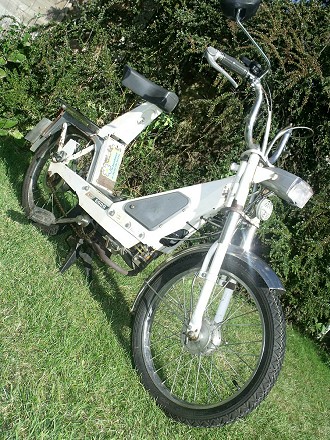
A VéloSoleX branded plastic cover tops the seat, on a saddle frame that pivots from the front, with a big coil spring behind, so that’ll be the rear suspension then!
Underneath the saddle is a spring-loaded ‘mousetrap’ toolbox lid, which opens at the back of the saddle. You can put in the usual basic essentials, plug spanner, spark plug, rag, maybe a small screwdriver, but at your own peril! The edges of the steel lid are sharp, and as you pull it back against the spring, the ‘snap’ becomes more dangerous … one slip, and next time you might be packing some sticking plasters too!
There’s only a cheap lightweight and flimsy pressed-steel stand, so it’s not going to be any good idea to pedal this up on the stand or it’ll certainly bend up… Oh, too late, it’s already suffered the inevitable fate, and the bike already leans like a drunken sailor.
The usual Solex cast alloy inverted levers operate the brakes, with a thumb trigger on the left-hand bar to work a decompresser valve in the cylinder head, and a right trigger for the throttle.
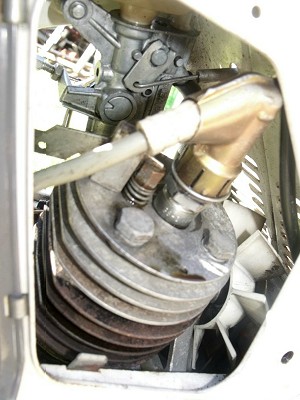

Since the rear axle is a fixed position in the frame, the pedal chain tension is adjusted by a swinging bottom bracket—but now just ‘a little strange’ is about to get a whole lot stranger… The rear hub is occupied by a left-hand shaft drive, and the rear braking is dealt with by a 160mm cable operated disc brake on the right-hand side! This would almost seem like off-world technology for VéloSoleX, or was this thing designed by space aliens?
The shaft drive is engaged by a lever on the lower left frame rail, which engages a dog-gear in the backward position and, switched to the front position, pulls the dog-gear forward and out of engagement to allow the machine to be either pedalled like a bicycle, or for easier navigation around a garage or for parking (since the engine turns over if it’s not out of engagement).
The fuel filler cap is just forward left of the lower frame rails, which is where the tank is located between them, and what looks like it might be an in-frame fuel tank from the steering headstock down to the front-lower frame rails, is actually a hollow pressed-steel frame section housing the engine!
The motor is the familiar Solex power unit, but turned 90° to enable a shaft drive output. Since the fuel tank is lower than the carburetter, a diaphragm pump lifts fuel to the weir carburetter, which overflows back to the tank in the usual Solex manner (normal to Solex, but unusual to anyone else). Since the 48cc, 1.4bhp air-cooled engine is tucked away in the metal frame housing, cooling air enters through a port in the front of the housing, to circulate around the engine fins, while warm air is vented out of the container through louvres in the back, and ‘encouraged’ on its way by a belt driven fan from the crankshaft! There are plastic covers on each side of the frame housing, which can be opened to access and service the spark plug and carburetter.
The exhaust pipe follows a convoluted route down and around the front of the motor, back and underneath, to a mid-mounted silencer above the stand. A choke knob pulls out-for-on halfway down the frame housing above the vents. There is no fuel to turn on, since it’s automatically pumped when the engine turns, no ignition switch, just engage the shaft drive lever, pull out the choke knob, maybe a bit of throttle, decompress, pedal off, then when you’ve got the engine turning, drop the decomp—and Flash starts straight away! Well that was easier than we thought!

We trickle up the road to a muffled and hooverish exhaust note, then try easing off the choke, but the running sounds to weaken, so pull the knob back out again before the motor dies. On round the corner and down the road, then after a few hundred yards the motor starts to four-stroke, so click in the choke knob, and Flash surges ahead with a burst of two-stroke power. A little farther down the road we ease back the throttle trigger to tick-over, and see what happens as we turn around. The revs go down with the drive disengaged, then open up the throttle lever, the revs go up, and the automatic clutch feeds in the power. OK, that’s all easy too! You can help to get up speed with a little pedal assistance if the situation calls for it, but the motor feels quite capable on its own along the flat.
We return to base from this brief first trial run to write some notes, and with the engine still running, just try the horn … to no effect … oh, the lights are on, so switch them off … err, no? The lights stay on in both switch positions, and seem pretty dim at low revs. That’ll be electrics: nil points!
The Huret speedo is marked 0–60, but doesn’t actually tell you if this is graduated in km/h or mph—what do you think?
Along the flat at an indicated 35, our pacer clocked 22mph, and a best of 27mph downhill (indicated 42), so we reckon the speedo indicates in km/h. Generally Flash bumbles and rattles along at an indicated 30–35km/h, so around 20–22mph. The brakes and general handling proved quite adequate for the limited performance. The bike completed its tasks confidently enough, though it rode in a very basic manner, without much impression of comfort or any form of luxury. Despite all the developments, it’s still just low-budget transport.
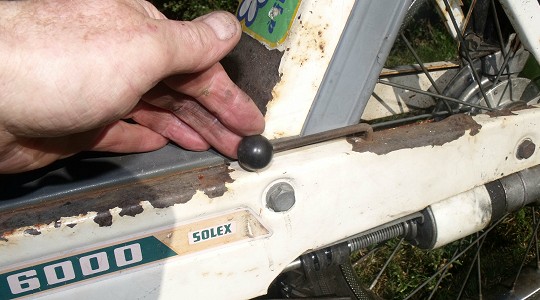
In 1973, the ‘6000 Standard R’ was added to the range as an intermediate version with a rigid fork (but one that looked like a telescopic fork), and drum front brake. 1973 prices were: Standard: F697, Standard R: 710F, Télescopique: 835F.
Around this time the Renault car company was seeking to gain an interest in the two-wheeler market, acquiring a 33% interest in MICMO–Gitane, and a 51% interest in VéloSoleX, which catapulted Renault straight into third position in the league table of French motor cycle manufacturers. However, in December 1974, Renault traded its majority holding in VéloSoleX, for a 15% interest in Motobécane, and so VéloSoleX passed into the hands of its former rival.
At the Paris Salon in October 1975, Motobécane, Motoconfort, and VéloSoleX shared a common stand, and although the 6000 was exhibited along with the 3800, 5000, and Ténor models, it would not be long before the VéloSoleX range was reduced to just the 3800.


